#fort meigs
Explore tagged Tumblr posts
Text

Hey @identifying-cannons-in-posts 👀
#fort meigs#war of 1812#gun gin#living history#dressed to kill#cushing's company#us army#2nd U.S. Artillery#napoleonic#consider allowing submissions?
46 notes
·
View notes
Text

Always a good day when you get a call from a War of 1812 fort 😄
5 notes
·
View notes
Photo
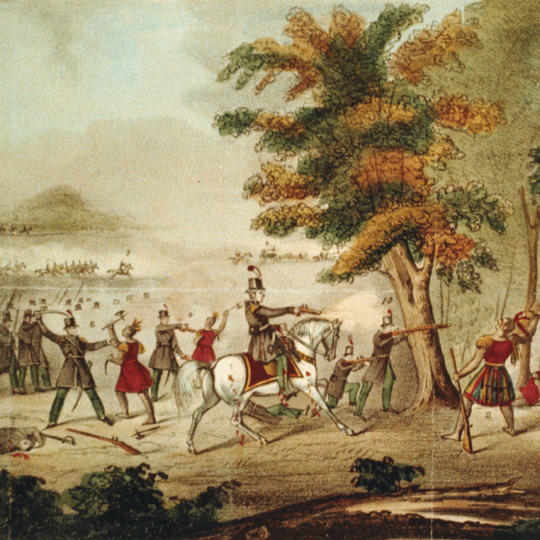
Battle of the Thames
The Battle of the Thames (5 October 1813), or the Battle of Moraviantown, was a decisive engagement in the War of 1812, in which a US army under General William Henry Harrison defeated a British and Native American force in Upper Canada. The battle resulted in the death of the Shawnee chieftain Tecumseh and the dissolution of his intertribal confederacy.
Battle of the Thames
William Emmons (Public Domain)
Background: The Struggle for Michigan
On 16 August 1812, less than two months after the War of 1812 had been declared, the British captured the major US outpost of Fort Detroit without a fight, giving them control of the entire Michigan Territory. This decisive victory could not have been achieved without the help of several northwestern Native American nations, who had sided with the British in order to resist the aggressive westward expansion of the United States. Under the charismatic leadership of the Shawnee chieftain Tecumseh, these Native American nations were in the process of joining together in a new intertribal confederacy, with the goal of recovering lands they had lost to the US after the disastrous Battle of Fallen Timbers (20 August 1794). Britain was eager to support this new confederacy, viewing it as a potential buffer state between the US and Canada, and promised to help set up the Native Americans on lands west of the Ohio River.
The United States, anxious as it was to prevent a hostile, British-backed Native American confederacy from arising on its western frontier, was determined to nip the threat in the bud by reconquering Michigan. This task was allotted to Major General William Henry Harrison, the popular hero of the Battle of Tippecanoe, and his newly formed Army of the Northwest, comprised mainly of volunteers from Kentucky and Ohio. In early October 1812, Harrison set out towards Detroit, but his progress was hindered by poor logistics and bad weather. Forced into winter quarters by January 1813, Harrison faced additional difficulties when the leading column of his army – at the small settlement of Frenchtown, Michigan, on the River Raisin – was attacked and defeated by a British and Native American force. After the battle, the British soldiers withdrew to Detroit, taking their able-bodied captives but leaving behind those Kentuckian prisoners who were too wounded to walk. When night fell, many of these wounded Kentuckians were massacred by Potawatomi warriors allied with the British, who desired vengeance for their villages that had been burned by Harrison's army during its advance through Ohio.
Harrison, upon learning of the defeat at the Battle of the River Raisin, withdrew the rest of his army to the Maumee River, where he hastily built Fort Meigs in February 1813. For the next several months, the Army of the Northwest remained holed up in the fort, even withstanding a brief siege in May. Before he could continue his advance toward Detroit, Harrison knew that the Americans needed to gain control of Lake Erie; possession of the lake would allow them to more easily reinforce and resupply their army in Michigan. With this goal in mind, the Americans built nine vessels on the lake, which were placed under the overall command of Master Commandant Oliver Hazard Perry.
The Battle of Lake Erie
Julian Oliver Davidson (Public Domain)
In late August, Perry moved his naval squadron to Put-in-Bay, Ohio, a position from which he could blockade the main British outpost along the lake, at Amherstburg in Upper Canada (present-day Southern Ontario). A squadron of six British ships, under Robert Heriot Barclay, sailed out to meet this threat, culminating in the Battle of Lake Erie (10 September 1813), in which Perry prevailed, capturing the British vessels; as Perry himself would put it in his report to Harrison, "We have met the enemy and they are ours." With the Americans in control of Lake Erie, Harrison was free to resume his advance toward Detroit. In mid-September, his army marched into Michigan along the lakeshore, supplied by Perry's victorious ships in the lake.
Continue reading...
30 notes
·
View notes
Photo


Fort Meigs, Memorial Day weekend 2023.
Fort Meigs is the largest timber palisade fort built in North America.
Built on the banks of the Maumee River outside of present-day Perrysburg Ohio under the command of Gen. WIlliam Henry Harrison in February 1813 during the War of 1812. Following the defeat of Gen. WInchester’s forces at River Raisin/Frenchtown and the surrender of Gen. Hull at Detroit, US forces quickly needed to establish a fortified position and supply point for eventual operations into Canada and to recapture Detroit. Unsuccessfully besieged by British and native forces in 1813, the fort was dismantled after British forces departed the area, and was abandoned soon after the war. It was reconstructed in the 1960s on the same site featuring the extant original earthworks.
2 notes
·
View notes
Photo

Siège de Fort Meigs
Le siège de Fort Meigs (du 28 avril au 9 mai 1813) fut un engagement majeur sur la frontière nord-ouest de la guerre de 1812. L'armée américaine du major général William Henry Harrison, retranchée dans le fort Meigs construit à la hâte, résista au siège des forces britanniques et autochtones malgré de lourdes pertes.
Lire la suite...
0 notes
Text
He poisoned the well, every man for himself
So she became “The Man” because “they say all’s well that ends well, but I’m in a new hell every time you double cross my mind.” She says “X marks the spot” twice in getaway car… double cross..?
H e double hockey sticks..
Hell
851212 6/13
6/13/2024 was the 100th show in Liverpool, during the surprise song set she said “I can do it with a sniffly nose.” A play on ICDIWABH.
*it was also at this show that she confirmed that the tour would be ending in December. “This is the first time I have admitted to myself out loud that the tour is ending in December”
*it ends with us was released on 8/9/2024 Blake said it was a good movie to go see with “friends.” Which is funny since her husband is in the movie “Just Friends.”
*the screen also “Glitched” during “Mastermind” 18 13 (added together it still equals 13.)
1/18-1/23/1813 The War of 1812
*thats silly on TVD they flashback to 1912.
1/24/1813 The Philharmonic Society is founded in London
1/31/1813 The Assembly of the Year XIII is inaugurated in Buenos Aires.
*shows 58-60 were played in Buenos Aires. 11/11 was the first mashup performed and included end game. 3/7 surprise songs sang those nights were 1989. 2 from the vault.
2/11/1812: Construction begins on Fort Meigs in Ohio
*located at 29100 W River Rd, Perrysburg, OH 4355. With a total of 10 acres. The British Army supported by Tecumseh’s Confederacy, failed to capture the fort during the Seige of Fort Meigs. Also on 4/8 Colonel James Ball arrives with 200 dragoons.
3/1813 the Malta Plague
4/27/1813 US troops raid and destroy but do not hold capital of Upper Canada, York (Modern Day Toronto.)
*2nd to last city. 1st city in Canada. (12). This tour stop also has 6 shows. 12/6 is 2 days before tour ends and the 1st show in Vancouver. (12 again)
9/4/1813 The name of Germany’s national card game “scat” appears for the first time, in the gaming records of Hans Carl Leopold von der Gabelentz (don’t call him Gabe)
9/10/1813 Battle of Lake Erie
10/24-11/5/1813 Persia and Russia sign the Treaty of Gulistan at the end of the Russo-Persian War, by which Persia loses modern-day Georgia, Dagestan and most os Azerbaijan to Russia.
11/11/1813 Battle of Crysler’s Farm.
11/21/1813 An independent government is formed in the Netherlands
12/8/1813 Ludwig van Beethoven’s Symphony No. 7, together with his Wellington’s Victory, are premiered in Vienna. For a benefit concert for Austrian and Bavarian soldiers.
*12/8 is the last day of the tour
*the three Vienna shows were cancelled due to a terrorist threat.
Those shows were #127, #128, and #129.
She is in Vancouver for the last stop on 12/6, 12/7, and 12/8
#128 12/8
12/7 is N2 in Vancouver and 12/8 is N3… thats 3,2 mirrored. Exile ends in 3…2… and there was only 1 city that she completely had to cancel.. and on top of that Billy Joel was seen recently at a show wearing probably the best choice of shirt possible “We Didn’t Start The Fire.” I think it’s dope when artists wear their own merch, they aren’t afraid to show that they are proud of the work they have done. And that song is so important to history.
12/8 mirrored date of 8/12 happy anniversary C&M… holy shit
C 3
A 1
M 3
3AM.
You picked your wedding date on purpose!!!
Midnights letters added up equals 58 which equals 13.
But mirrored is 85, like 1985 perhaps? Her dreams went out the door when she turned 24…. Ya I’d say that hits a nail on the head. “She hates time, make it stop”
12/8 is also National Christmas Tree Day— Christmas Tree Farm
National Take it in the Ear Day— on 7/13/2024 Donald Trump was shot in the ear in PA during an assassination attempt.
Ahh there it is
12/8/1861 happy birthday William Durant (founded GM and Chevrolet. He died in 1947)
*Kevin Durant comes to mind especially since this day in history the NBA ended their lockout- he and Monica Wright end their engagement 3 years later.
12/8/1872 American Mormon leader Brigham Young marries his 55th and final wife, American poet Hannah Tapfield.
*I can’t Drive 55..?
*is this why she is flashing 55 during the 22 set?
12/8/1980 John Lennon died in NYC, or did he..?
How in the hell were there 4 aircraft crashes on this day in history? Even one was struck by lightning. And one struck an apartment complex. This world has been a dumpster fire.
12/8/2006 Scott Baio marries Renee Sloan
*I know a girl with a daughter that has that name. She’s also a KC fan. Has a dog named Kelce too.
12/8/2007 Tim Tebow, Florida QB wins the 73 Heisman Trophy Award
12/8/2011 After a 161 day lockout that shortened the season by 16 games the NBA and players union reach a financial agreement.
12/8/2013 Metallica plays a show in Antarctica sponsored by Coca-Cola Zero. Making them the first band to perform on all seven continents.
12/8/2019 was the first confirmed case of COVID-19 in China
*or was it another plot to take out the LGTBQ community just like 38 years prior?
Okay so there will have been play 149 shows total
This equal 14
There were 3 shows that were cancelled
143 I love you “3 words, 8 letters, say it and I’m yours” OMG SHE IS WEARING YELLOW AND GREEN IN THIS SCENE. I’m also still bummed that Gossip Girl wasn’t Blair’s maid.
3/14
Pi day
Dribble to work day - “you know how to ball”
International day of mathematics
Learn about butterflies day
Save a spider day- “spider boy, king of thieves.”
Write your story day
3/14/1879 Albert Einstein DOB
3/14/1883 Karl Marx DOD
3/14/1932 George Eastman DOD, he invented and founded the Eastman Kodak
3/14/1946 Ernest Hemingway marries Mary Welsh- Mary’s Song?
3/14/1950 FBI’s 10 most wanted fugitives program begins.
3/14/1958 the first ever Gold Record is awarded for sales of a million copies to Perry Como for Catch A Falling Star.
3/14/1967 the body of JFK is moved to a permanent burial place at Arlington National Cemetery.
3/14/1972 Carly Simon wins best new artist at the Grammys
TS quoted You’re So Vain
3/14/1978 The NFL permanently adds 7th official, a side judge
3/14/2005 The Pretenders are inducted to the Rock and Roll Hall of Fame.
*bring on the pretenders.. Long Live
0 notes
Text

On Aug. 7, 1861, soon after the Union defeat at Manassas, Va., made it clear the Civil War would not end quickly, Union Quartermaster General Montgomery C. Meigs awarded engineer James B. Eads a contract to build seven armored gunboats for the Army’s Western Gunboat Flotilla. The City-class gunboats—designed by Eads, Commander John Rodgers and naval constructor John Lenthall and modified by Eads and naval architect Samuel M. Pook—were all commissioned by February 1862. “Pook’s Turtles,” as they were known, soon established themselves as the most powerful warships in the Western theater of operations.
The City-class gunboats differed only in detail. Mound City, whose specifications are listed in the illustration here, saw action along the Mississippi at Island No. 10, Fort Pillow/Plum Point Bend, Steeles Bayou, Grand Gulf and Vicksburg, as well as on the White and Red River campaigns. On May 10, 1862, off Fort Pillow, Confederate rams twice struck the Union gunship, which withdrew to shallow water and sank; Union shipwrights quickly returned it to service. During the bombardment of St. Charles, Ark., on June 17, 1862, a Rebel shore battery penetrated Mound City’s armor and steam drum, killing 125 of its crew and scalding another 25. Repaired once again, the gunboat served through war’s end and was decommissioned within weeks of the surrender at Appomattox.
0 notes
Text
Oliver House, Maumee Bay Brewing Comapany
The Oliver House is a former hotel which now is actively open as a Brewery, pub, Steakhouse, cafe and museum. The Oliver House is Located in the downtown district of Toledo, Ohio At 27 Broadway St.
The Oliver House is named after Major Williams Oliver, (Major Williams Oliver was known for fighting in the war of 1812 at Fort Meigs). The Oliver House was said to be predating the city of Toledo by almost 2 decades, And it was said that from 1817 -1833 The area hosted buildings acting as saloons and shared room hotels. It was the only known source of entertainment in the area at the time.
It wasn't until 1859 When Major William Oliver Commissioned a gentleman by the name of Isaiah Rodgers to build a luxury hotel. Isaiah Rodgers did just that creating a luxury hotel with 171 rooms with running water, gas lighting and fireplaces. The hotel offered private rooms with grand views of the river. It was a modern wonder to all who came to the newly thriving city.
Along with the grand hotel Isaiah Rodgers gained national recognition as Chief of the Bureau of Construction in the U.S. Treasury Department, a position appointed to him by President Lincoln. Lincoln also was one known president to stay in the luxurious Oliver House Hotel while visiting the city for a funeral.
Just 2 years after the construction of the Hotel, Civil war had broken out. The thriving hotel became one of main passages for the underground Railroad, mainly due to its location to the river. If you visit the Oliver House today located in the basement is a brick archway where the slaves would travel through and out upon the river awaiting their way to Canada.
The Oliver House Hotel thrived until around 1894 and the hotel became vacant due to the modern electricity taking over and leaving little to no desire for gas lighted establishments. Just 1 year later in 1895 The vacant hotel was officially "Not Running." The hotel warehouse sat vacant and became a flop house causing much drama and possible murders & death..
Until the 1900 When the Spanish American war broke out And the hotel was once again opened and acted as a informory for veterans of the war. Injured soldiers were brought by train to the makeshift infirmary where the second floor of the hotel was transformed into a hospital for sick and injured soldiers. The basement was suspected to be the morgue for the deceased.
One well known military apparition known as "The Captain" has been reported to roam the halls in the Oliver house. The Captain has been seen in the Dining room and Pool room, other reports claim to have seen him in the elevator shaft and on the staircase. The Captain is known to have a kind disposition and seems happy to see updates and patrons still roam the hotel.
After the hotel was used for its infirmary purposes in 1919 a gentleman by the name of Edward D Riddle took over the hotel. Edward had the hotel gutted clean leaving only the shell of the historical Hotel. Edwards had the empty space constructed into an industrial plant.
Almost 20+ years later the Now transformed Oliver house Hotel, infirmary, and plant was once again turned over in 1947 And became the Wheel and Axle manufacturer.
It wasn't until another 20 years in 1967 when the building had changed again now becoming storage of novelty items for the Successful Sales Co Along with other small businesses.
During the renovations in the 1960's a garage door was to be installed in the building, while the construction crew dug up the foundation they had discovered human remains. There is no real report as to what happened to the said remains. Some rumors say the Construction crew who originally found the remains left them and built over them. Other reports say they were dug up and placed in a nearby cemetery. The remains were later Named "The Grandfather". Other rumors reported that William Oliver himself was buried under the basement and when the soil was examined it was reported the soil had come from Transylvania. Leading a suspicion that William Oliver was a vampire. This was never noted as fact. It was on the other hand That the Oliver House was known to be built on ancient Indian burial lands.
During the next 20 years there seemed to be a calm and quiet disposition with the ever changing building. Maybe a quiet before the storm,
The Oliver House sat in some state of peace.
Until the 1980's when parts of the building were being rented out to local bands for rehearsals and practice. One musician claimed seeing an apparition of a woman in a long white dress standing at the staircase leading from the private dining room. This Ghostly woman has since been referred to as the "White Lady."
Now It would be almost 50 years later before the building took on another owner. In 1990 Jim and Pat Appold Took over ownership of the historical Oliver House. It was then when the duo decided to have some renovations done to the old building. That is when the real ghostly things started to happen. Contractors reported missing tools, voices in the pool and dining room, and other strange noises. One contractor reported his name being called several times to see no one there. Another worker rushed out of the building after hearing footsteps following him. A bricklayer, while working on the building during the 1990s renovation, was fixing up an apartment in one of the units, where he could stay during this work endeavor. When going up the various staircases to get to his room one evening, he heard the heavy footsteps of an unseen presence following up after him, which would stop when he stopped and continued when he did. He made a hasty bee-line into the apartment. Perhaps this is an entity of a soldier who had died in the building.
In 1994 During said reconstruction Remains were again found under all the brick and concrete, they were presumed to be from the ancient burial Grounds. So a tribe from the west was called out to rebury the remains and perform a ceremony.
In 1995 The completion of remodeling was over and the opening of the Oliver House & Now Maumee Bay brewing company had reopened the doors offering Brews from century old recipes. During the first few years that the Appolds opened up the pub-restaurant, their daughter and son-in-law helped to run the business. The daughter said she was in the private dining room one night where she heard a cheery but faded voice calling her name, the voice was coming from the half-finished pool room, located directly below the private dining room area
The Oliver house holds a long running and fluctuating history, With all this building had seen There is bound for some ghostly sightings, Such as the white lady and The captain, Still to this date there are several haunting reports of the Oliver House. Some of these include hearing the floorboards creak under the weight of an unseen presence. Doors open and close with no assistance, they also become stuck for no apparent reason. People get chills and feel cold spots in this room. People feel an unseen presence watching them. Some of the areas that are reported to see activity is the staircase, the pool room and dining room. The elevator and basement had reports of sightings.
Upon my own visit in the liver house the hostess had confessed being touched on her arm by an unseen person while standing in the lobby at her post. I myself experienced a bit of uncomfortable watching feeling while exploring the walls in the downstairs restroom. Unfortunately I did not experience “The Captain '' nor the “White Lady’ but maybe in one of my future visits I'll get the opportunity.
A psychic who investigated the building had reported a lot of uneasy, unhappy energy here, left over from some traumatic experiences of the past, which could have come from disgruntled Indian spirits, soldiers, or the flop house experiences or some other unfortunate event.
In Closing Toledo Ohio's oldest building and very haunted Oliver House / Maumee Brewing Company holds a deep dark and ghostly history nestled among the beautiful brick walls and wooden staircases. With plenty of hauntings and ghostly guests who still remain.
The Oliver House Maumee Bay Brewing Company is a place to mark on your map of places to see, So if you find yourself in city of Toledo make sure to travel down by the river and enjoy a meal and some on the spot brews and maybe you will have your very own paranormal encounter at the Beautiful Historical and Haunted Oliver House / Maumee Bay Brewing Company.
*As of Now I am Aware this Establishment is open during the pandemic.
for dine and carryout.
For more information on this establishment go to www.mbaybrew.com
1 note
·
View note
Photo

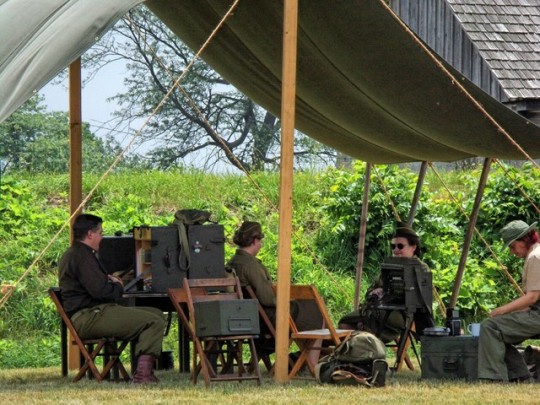
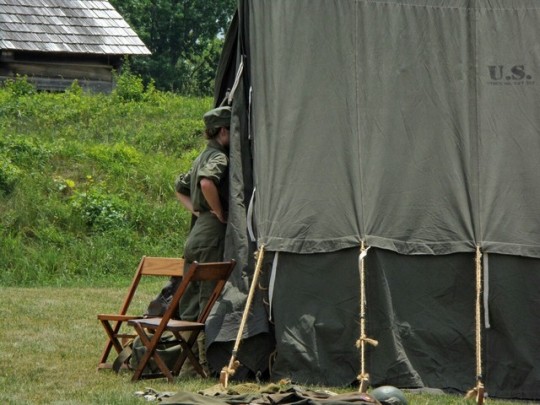
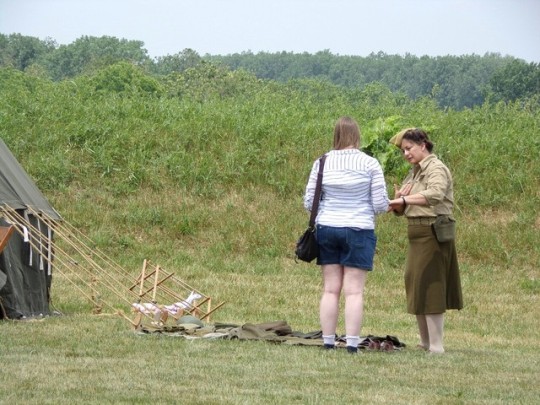
This Saturday I attended Muster on the Maumee at Fort Meigs in Perrysburg, Ohio. My sole reason for going was to meet the 1st WAC Separate Battalion because they’re the reenacting group I’ve been talking to on Facebook. (that’s me in the last pic btw. in the blue shirts and white top. my mom snuck a photo without me knowing). They were really nice girls and they were so welcoming!! They showed me around and let me hang out with them and we just chatted. I hope I didn’t overstay my welcome or come across weird or something. They were so nice. I’d love to join them officially! Just gotta get me a uniform now!
#wac#waac#1st wac separate battalion#wwii#wwii reenacting#women in wwii#women reenactors#stephs stuff#fort meigs#muster on the maumee#my pics
21 notes
·
View notes
Text

A War of 1812 reenactor at Fort Meigs showing the amount of soot generated by only a few shots of his musket (the poor man also had soot on his face).
Even if they don't fire real bullets (for obvious safety reasons), I appreciate the fact that the fort’s reenactment group uses real flints for their locks!
#war of 1812#living history#fort meigs#us army#military history#flintlock#firearms#black powder#unfortunately the sharpest picture has the most ruffled-looking clothes on the reenactor#nice peek at his shirt tho#historical reenactment#1810s#napoleonic#dressed to kill
61 notes
·
View notes
Video
Found Slide by Thomas Hawk
0 notes
Photo

Siege of Fort Meigs
The Siege of Fort Meigs (28 April to 9 May 1813) was a major engagement on the northwestern frontier of the War of 1812. It saw a US army under Major General William Henry Harrison, holed up in the hastily built Fort Meigs, withstand a siege by British and Native American forces despite heavy casualties.
Siege of Fort Meigs
D.W. Kellogg & Co. (Public Domain)
Background
On 16 August 1812, the US outpost of Fort Detroit surrendered to a British and Native American force after a brief and nearly bloodless siege. At a stroke, the British had seized control of the entire Michigan Territory, which they could now use as a staging ground for an invasion of western US states like Ohio or Kentucky. Even worse from a US perspective, the Siege of Detroit had emboldened several previously neutral Native American nations to side with the British and begin to attack US outposts and settlements. Many of these northwestern Native Americans had been driven from their lands by the US after the Battle of Fallen Timbers (20 August 1794) and were eager to reclaim what they had lost; indeed, the British promised to help the Native Americans set up their own, independent confederacy on lands west of the Ohio River. Such a confederacy would serve British interests by acting as a buffer state between Canada and the US.
The US was anxious to prevent a hostile, British-backed Native American confederacy from arising on its western frontier and knew that it had to balance the scales by retaking Detroit. Such an important task was entrusted to William Henry Harrison, the popular former governor of the Indiana Territory and the hero of the Battle of Tippecanoe (7 November 1811). Harrison was given the rank of major general and placed in command of the newly formed Army of the Northwest, comprised mainly of raw volunteers from Kentucky and Ohio serving six-month enlistments. In early October, this army set out from Fort Defiance in Ohio, but bad weather and poor logistics slowed its advance to a crawl. Before long, winter was setting in, and Harrison begrudgingly concluded that he would be unable to assault Detroit before spring. He ordered the advance column of his army, under Brigadier General James Winchester, to continue marching to the Maumee Rapids (near present-day Toledo, Ohio) where they would begin setting up camp for the winter.
Winchester's men arrived at the Maumee Rapids in mid-January 1813. Having been on the march for weeks by this point, most of these men were cold, wet, and hungry; many of their enlistments were about to expire, and they longed to fight a battle before being sent home if only to make their long miles of miserable marching worth it. They would soon get an opportunity, as word reached their camp that a detachment of Canadian militia had occupied Frenchtown, a small community on the River Raisin in Michigan, and was harassing its inhabitants. The Americans begged Winchester to let them march to Frenchtown's rescue. Winchester, enticed by the prospect of an easy victory, relented and sent several companies of Kentuckians into Michigan.
The British-American War of 1812
Simeon Netchev (CC BY-NC-ND)
On 18 January, the Kentuckians easily routed the Canadians, causing an elated Winchester to move the rest of his column to Frenchtown as well. Once there, the inexperienced Americans grew complacent, neglecting to post adequate pickets or fortify their position. Therefore, the Americans were caught by surprise when a British and Native American force, under Sir Henry Procter, counterattacked just before dawn on 22 January. The Americans were defeated, and many were killed in the fighting. Of the survivors, those who could walk were taken across the Detroit River to Amherstburg as prisoners, while those too wounded to move were left behind in Frenchtown. That night, many of these wounded would be massacred by Potawatomi warriors allied with the British.
Continue reading...
18 notes
·
View notes
Text
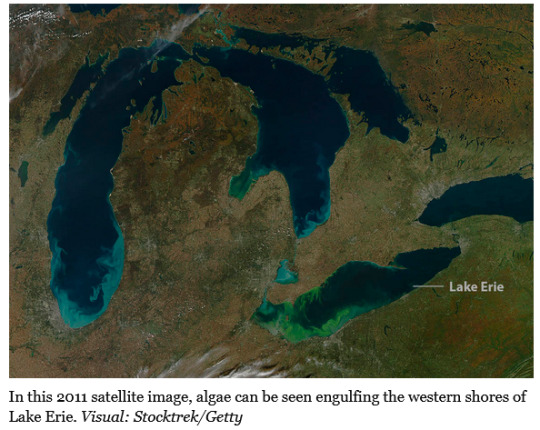

On Saturday, August 2, 2014, the water supply for the city of Toledo, Ohio, was poisoned. Officials issued an unequivocal order to the half million residents connected to the municipal intake: Don’t drink, cook, or brush your teeth with the water. [...] Stores ran out of bottled water, leaving residents to queue up at local fire stations [...]. The culprit was a bright green plume of Microcystis, a cyanobacterium that thrives in warm water [...]. In spring, rains wash a pulse of nutrients off the surrounding region’s fertilized farms and send it down the Maumee and Sandusky Rivers and into western Lake Erie. [...] Tests showed that the city’s water contained dangerous levels of microcystin, a liver toxin produced by the bloom.
The source of the problem stretches for thousands of square miles across northwestern Ohio and eastern Indiana. The rich earth [...] in the region produces hundreds of millions of dollars’ worth of soybeans and corn, as well as wheat, vegetables, pork, and poultry. The landscape is a vast, flat expanse of tidy fields and modest farmhouses crisscrossed with county roads — but it wasn’t always this way.
Centuries ago, this part of the Midwest was a wild expanse of wet forest and marsh stretching across a million acres, and early settlers who slogged through the muck and mosquitoes called the place the Great Black Swamp. [...] On an 1808 map, the swamp, which covered most of northwestern Ohio, was designated as “land not worth a farthing.”
But settlers came anyway, felling the giant sycamores and oaks to create roads, and digging miles of drainage trenches to slowly bleed the water away from the muck. [...]
They [”the wetlands”] are considered a menace, a threat, a thing to be overcome. These attitudes are enshrined in state law, which makes impossible any action, including wetland restoration, that slows the flow of runoff through those miles of constructed drainage ditches [...].
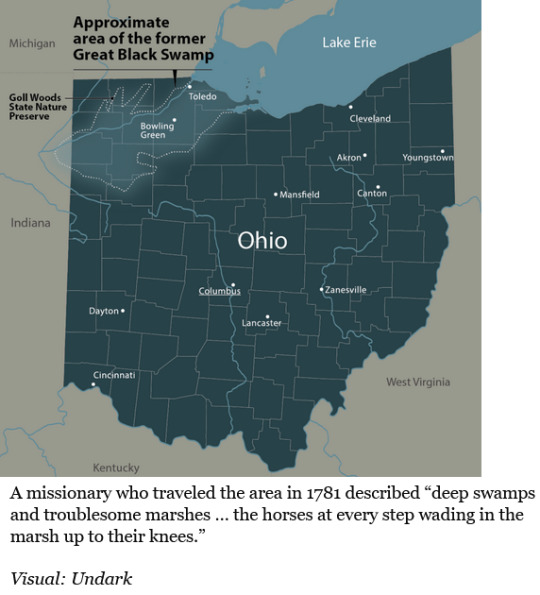
[S]oldiers recorded the striking bounty of the Black Swamp and Lake Erie’s southwestern shore. On an April morning in 1813, two hungry soldiers stationed at Fort Meigs, near present-day Toledo, walked down to the Maumee River. The clear waters swarmed with perch, muskellunge, sturgeon, and catfish. Plunging spears into the water at random, they caught 67 fish in 30 minutes, often killing two or three with a single stroke. Every river mouth west of the Sandusky held dense beds of wild rice, where waterfowl settled to feed, then rose in flocks that darkened the sky. The rice stalks stood taller than a man’s head: to feed, ducks grabbed the stems with their feet and tugged the seed heads down to the water. [...]
In 1859, the Ohio General Assembly passed a law authorizing county commissioners to construct drainage ditches. Farmers benefiting from ditch construction shared the cost. The other Midwestern states also enacted laws authorizing drainage districts, enabling the construction of vast networks of ditches that drained great swathes of land — a mission that required investment and coordination, and could not have been accomplished by individual landowners.
Through the work of drainage districts, the Corn Belt states would lose more than 95 percent of their native wetlands. [...]
Some enterprising soul tested the abundant clay that lay a foot or two beneath the soil of the Black Swamp, and found that it made excellent tiles.
By 1880, more than 50 tile factories operated in northwest Ohio, and the Black Swamp was dismembered and used to feed an accelerating and diversifying cycle of human industry.
The great wetland trees — ash, elm, oak, sycamore — were felled and used to build houses, make furniture, and power the railroads that sprouted up across Ohio. In the 1860s, Ohio’s railways consumed one million cords of wood each year as fuel, and an unknown quantity for ties. The discovery of underdrainage created a growing demand for tile. All this drove an orgy of forest clearing and land draining which in the course of five decades, from 1870 to 1920, completely erased the Black Swamp. A wilderness went up in the smoke from railroad engines, and flowed in drainage ditches down to the Maumee and Sandusky, which began to run murky and lost their once-bountiful populations of fish.
Among the descendants of the settlers who conquered the Black Swamp, drainage is viewed as sacred, while wetland restoration borders on the profane. In terms of water quality, a prime place to create wetlands would be where they intercept the flow of polluted water in farm ditches. That could cause water to back up and flood the fields, however, and it is forbidden under Ohio’s ditch laws, which have changed little since 1859.
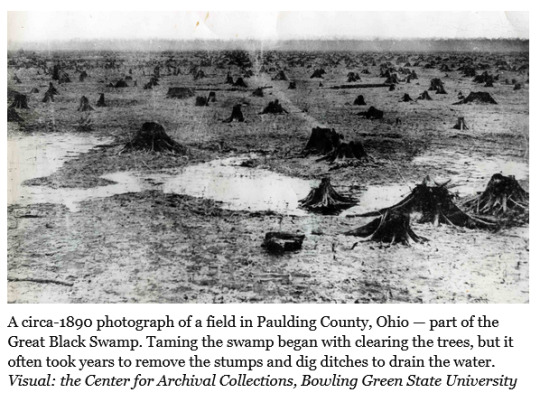
-------
All text, images, and captions published by: Sharon Levy. “Learning to Love the Great Black Swamp.” Undark. 31 March 2017. [Bold emphasis and some paragraph breaks added by me.]
2K notes
·
View notes
Photo

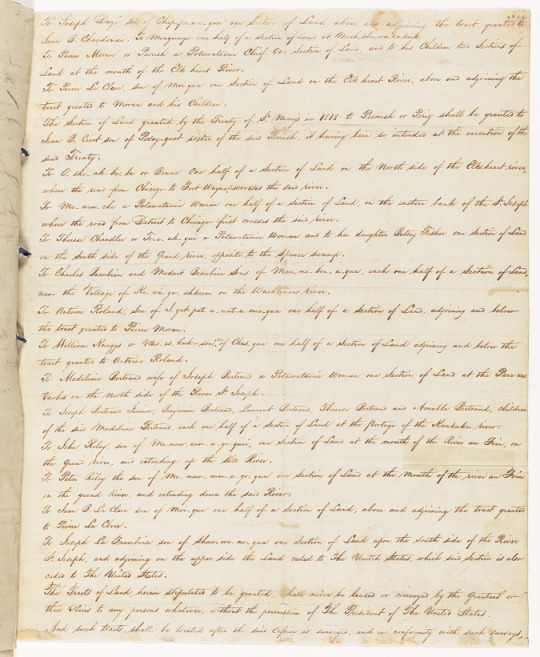
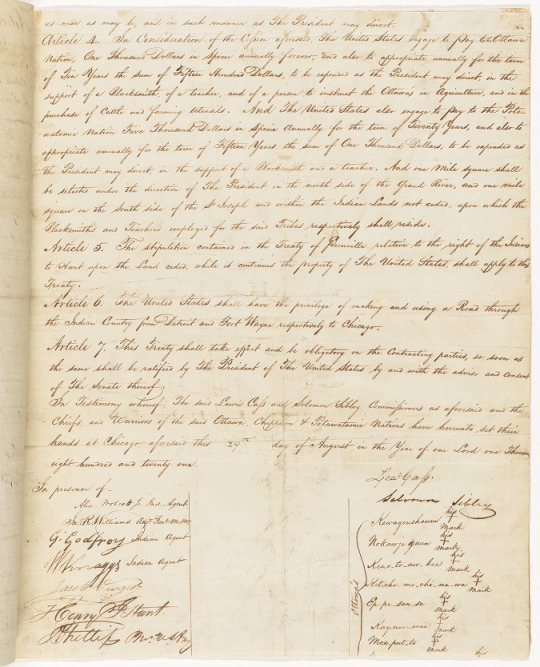
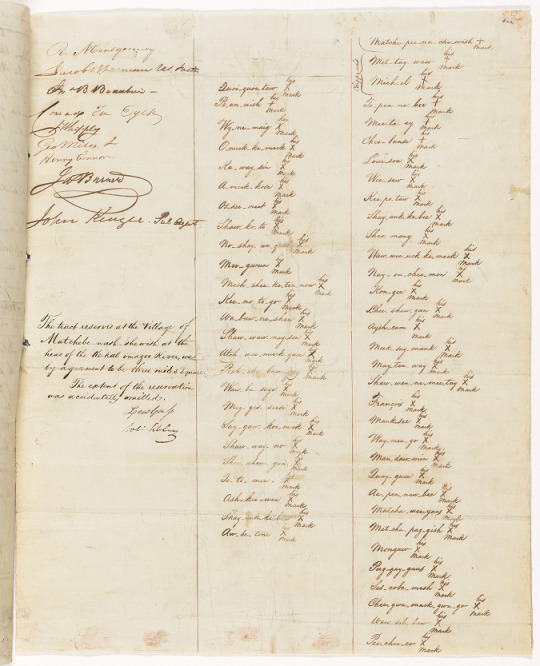
Treaty Between the United States and the Ottawa, Chippewa, and Potawatomi Indians Signed at Chicago, Illinois, 8/29/1821
File Unit: Ratified Indian Treaty 117: Ottawa, Chippewa and Potawatomi - Chicago, August 29, 1821, 1789 - 1869
Series: Indian Treaties, 1789 - 1869
Record Group 11: General Records of the United States Government, 1778 - 2006
Transcription:
Articles of a Treaty made and concluded at Chicago in the State of Illinois between
Lewis Cass and Solomon Sibley Commissioners of The United States, and the Ottawa, Chippewa, and
Pottawatamie Nations of Indians.
Article I". The Ottawa, Chippewa and Pottawatamie Nations of Indians Cede to the United States all
the Land comprehended within the following boundaries: Beginning at a point on the South bank of the River
St. Joseph of Lake Michigan, near the parc aux Vaches due North from Rum's Village, and running thence
South to a line drawn due East from the Southern extreme of Lake Michigan, thence with the said line East
to the tract, ceded by the Pottawatamies to the United States by the Treaty of Fort Meigs in 1817. if the said
line should strike the said Tract, but if the said line should pass North of the said Tract, then such line shall
be continued until it strikes the western boundary of the Tract ceded to the United States by the Treaty of Detroit
in 1807, and from the termination of the said line following the boundaries of former cessions to the main branch
of the Grand River of Lake Michigan, should any of the said lines cross the said River, but if none of the said
lines should cross the said River, then to a point due east of the source of the said main branch of the said
River, and from such point due West to the source of the said principal branch, And from the crossing of
the said River, or from the source thereof, as the case may be, down the said River, on the north bank thereof
to the mouth; thence following the shore of Lake Michigan to the south bank of the said River St. Joseph,
at the mouth thereof and thence with the said south bank to the place of beginning.
Article 2. From the Cession aforesaid, there shall be reserved, for the use of the Indians, the following Tracts,
One tract at Mang-ach-qua Village on the river Pebl'e, of six Miles square. One tract at Mick-ke-saw-be- of
six Miles square.
One Tract at the Village of Na-to-wa-se-pe of four miles square.
One Tract at the Village of Prairie ronde of three Miles square.
One Tract at the Village of Match-e-be narh-she-wish, at the head of the Kekalamazoo river.
Article 3. There shall be granted by The United States, to each of the following persons, being all Indians
by descent, and to their heirs the following tracts of Land.
To John Burnet, two sections of Land.
To James Burnet, Abraham Burnet, Rebecca Burnet, and Nancy Burnet each one section of Land. which said
John, James, Abraham Rebecca and Nancy are Children of Kaw-kee-me sister of Top-ni-be principal Chief of the
Potowatamie Nation.
The land granted to the persons immediately preceding shall begin on the north bank of the river St. Joseph,
about two miles from the mouth and shall extend up and back from the said river for quantity.
To John B. La Lime son of Noke-no-qua one-half of a Section of land, adjoining the tract before granted,
and on the upper side thereof.
To Jean B. Chandonai son of Chip-pe-wa-qua two Sections of Land on the river St. Joseph, above and ad-
-joining the tract granted to J. B. La Lime.
[page 2]
To Joseph Dazé son of Chip-pe-wa-qua one Section of Land above and adjoining the tract granted
to Jean B. Chandonai. To Monguago, one-half of a Section of Land, at Mish-she-wa-ko-kink.
To Pierre Moran or Peeresh a Potawatamie Chief One Section of Land, and to his Children two Sections of
Land at the mouth of the Elk heart River.
To Pierre Le Clerc, son of Moi qua one Section of Land on the Elk heart River, above and adjoining the
tract granted to Moran and his Children.
The section of land granted by the Treaty of St. Mary's, in 1818 to Peeresh or Perig shall be granted to
Jean B. Cicot son of Pe-say-quot sister of the said Peeresh, it having been so intended at the execution of the
said Treaty.
To O-she-ak-ke-be or Benac one half of a Section of Land on the North side of the Elksheart river,
where the road from Chicago to Fort Wayne first crosses the said river.
To Me-naw-che a Potawatamie Woman one half of a Section of Land, on the eastern bank of the St. Joseph
where the road from Detroit to Chicago first crosses the said river.
To Theresa Chandler or To-e-ak-qui a Potawatamie Woman and to her daughter Betsey Fisher one Section of Land
on the South side of the Grand River, opposite to the Spruce Swamp.
To Charles Beaubien and Medart Beaubien Sons of Man-na-ben-a-qua, each one-half of a Section of Land,
near the Village of Ke-wi-go-shkeem on the Washtenaw river.
To Antoine Roland, son of I-gat-pat-a-wat-a-mie-qua one half of a Section of Land, adjoining and below
the tract granted to Pierre Moran.
son
To William Knaggs or Was-es-kuk-son^ of Ches-qua one half of a Section of Land adjoining and below the
tract granted to Antoine Roland.
To Madeline Bertrand wife of Joseph Bertrand a Potawatamie Woman one Section of land at the Parc aux
Vaches on the north side of the River St. Joseph.
To Joseph Bertrand Junior, Benjamin Bertrand, Laurent Bertrand, Theresa Bertrand and Amable Bertrand, children
of the said Madeline Bertrand, each one half of a Section of Land at the portage of the Kankakee river.
To John Riley, son of Me-naw-cum-a-go-quoi, one Section of Land, at the mouth of the river au Foin, on
the Grand River, and extending up the said River.
To Peter Riley the son of Me-naw-cum-e-go-quoi, one Section of Land at the mouth of the river au Foin
on the Grand River, and extending down the said River.
To Jean B. Le Clerc son of Moi-qua one half of a Section of Land, above and adjoining the tract granted
to Pierre Le Clerc.
To Joseph La Framboise son of Shaw-we-no-qua one Section of Land upon the South side of the River
St. Joseph, and adjoining on the upper side the Land ceded to The United States, which said Section is also
ceded to the United States.
The Tracts of Land, herein stipulated to be granted, shall never be leased or conveyed by the grantees or
their Heirs to any persons whatever, without the permission of The President of the United States.
And such tracts shall be located after the said Cession is surveyed, and in conformity with such surveys,
[page 3]
as near as may be, and in such manner as The President may direct.
Article 4. In Consideration of the Cession aforesaid, The United States engage to Pay to the Ottawa
Nation, One Thousand Dollars in Specie annually forever, and also to appropriate annually for the term
of Ten Years the sum of Fifteen Hundred Dollars, to be expended as the President may direct, in the
support of a Blacksmith, of a Teacher, and of a person to instruct the Ottawas in Agriculture, and in the
purchase of Cattle and farming Utensils. And the United States also engage to pay to the Pota-
-watamie Nation Five Thousand Dollars in Specie Annually for the term of Twenty Years, and also to
appropriate annually for the term of Fifteen Years the sum of One Thousand Dollars, to be expended as
the President may direct, in the support of a Blacksmith and a Teacher. And one Mile square shall
be selected under the direction of The President, on the north side of the Grand River, and one mile
square on the South side of the St. Joseph and within the Indian Lands not ceded, upon which the
Blacksmiths and Teachers employed for the said tribes respectively shall reside.
Article 5. The stipulation contained in the Treaty of Greenville relative to the right of the Indians
to Hunt upon the Land ceded, while it continues the property of The United States, shall apply to this
Treaty.
Article 6. The United States shall have the privilege of making and using a Road through
the Indian Country from Detroit and Fort Wayne respectively to Chicago.
Artcile 7. This Treaty shall take effect and be obligatory on the Contracting parties, so soon as
the same shall be ratified by The President of the United States by and with the advice and consent
of The Senate thereof.
In Testimony whereof, The said Lewis Cass and Solomon Sibley Commissioners as aforesaid and the
Chiefs and Warriors of the said Ottawa, Chippewa, + Pattiwatimie Nations have hereunto set their
hands at Chicago aforesaid, this 29th day of August in the Year of our Lord one Thousand
eight hundred and twenty-one.
In presence of —
Alex. Wolcott Jr. Ind. Agent. Lewis Cass,
Jno. R. Williams, Adjt. Genl. M. Ma. Solomon Sibley.
Ottawa's{ [written vertically]
G. Godfroy Indian agent Kewagoushcum his + mark
W. Knaggs Indian agent Nokawjegaun his + mark
Jacob Visget Kee-o-to-aw-be his + mark
Henry I. Hunt Ket-che-me-chi-na-waw his + mark
A. Phillips PMsr. US Army Ep-pe-san-se his + mark
Kay-nee-wee his + mark
Mo-a-put-to his + mark
[page 4]
Mat-che-pee-na-che-wish his x mark
R. Montgomery Chippewa's{Met-tay-waw his x mark
Jacob B. Varnum US factor {Mich-el his x mark
John B. Beaubien - Quoi-quoi-taw his x mark To-pen-ne-bee his x mark
Conrad Ten Eyck Pe-an-nish his x mark Mee-te-ay his x mark,
J. Whipley Wy-ne-naig his x mark Chee-banse his x mark
George Miles J Onuck-ke-meck his x mark Loui-son his x mark
Henry Connor Ka-way-sin his x mark Wee-saw his x mark
James Barnerd A-meck-kose his x mark Kee-po-taw his x mark
John Kenzie. Sub Agent Os-see-meet his x mark Shay-auk-ke-bee his x mark
Shaw-ko-to his x mark Sho-mang his x mark
No-shay-we-quat his x mark Waw-we-uck-ke-meck his x mark
Mee-gwun his x mark Nay-ou-chee-mon his x mark
Mes-she-ke-ten-now his x mark Kong-gee his x mark
Kee-no-to-go his x mark Shee-shaw-gan his x mark
The tract reserved at the Village of Wa-baw-nee-she his x mark Aysh-cam his x mark
Matchebe-nash-she-wish at the Shaw-waw-nay-see his x mark Meek-say-mank his x mark
head of the Ke-kal-imazoo River, was Atch-wee-muck-quee his x mark May-ten-way his x mark
by agreement to be three miles square. Pish-she-baw-gay his x mark Shaw-wen-ne-me-tay his x mark
The extent of the reservation Waw-ba-saye his x mark Francois his x mark
was accidentally omitted. Meg-ges-seese his x mark Mauk-see his x mark
Lewis Cass Say-gaw-koo-nuck his x mark Way-me-go his x mark
Sol: Sibley Shaw-way-no his x mark Man-daw-min his x mark
Shee-shaw-gun his x mark Quay-guee his x mark
To-to-mee his x mark Aa-pen-naw-bee his x mark
Ash-kee-wee his x mark Mat-cha-wee-yaas his x mark
�� Shay-auk-ke-bee his x mark Mat-cha-pag-gish his x mark
Aw-be-tone his x mark Mongaw his x mark
Pug-gay-gaus his x mark
Ses-cobe-mesh his x mark
Chee-gwa-mack-gwa-go his x mark
Waw-seb-baw his x mark
Pee-chee-co his x mark
#archivesgov#August 29#1821#1800s#Native American history#Indigenous American history#treaties#Ottawa#Chippewa#Potawatomi
42 notes
·
View notes
Photo
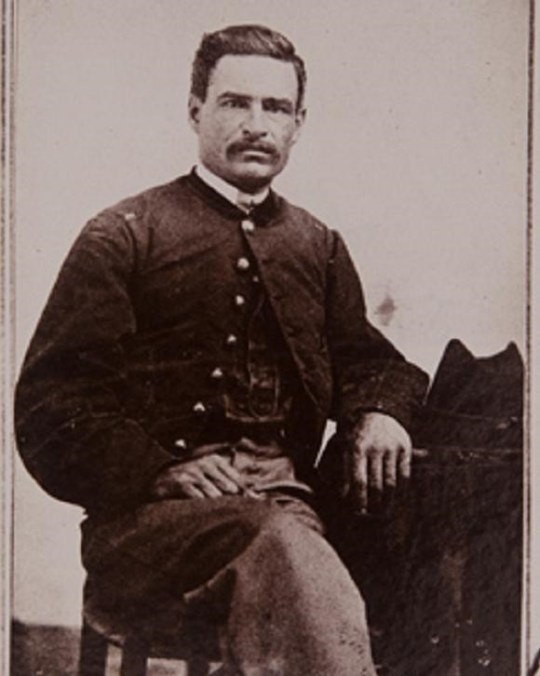
Born in Columbia, Pennsylvania in 1823, Stephen Atkins Swails grew up in south central Pennsylvania and western New York. In the years before his birth, Swails’ parents, freed persons from the slave state of Maryland, moved the family from the dangerous border state to Lancaster, Pennsylvania.
Following the Fugitive Slave Act of 1850, abolitionists and slave catchers frequently fought over the area. To avoid additional risks, Swails and his family relocated to the abolitionist center of Elmira, New York.
Swails worked as a waiter in Cooperstown, New York in April 1861 when the Civil War began. Swails shared the desire to serve in the war with other African American men who realized that it could radically change their status in the United States. However, the government prohibited their enlistment until the Lincoln administration issued the Emancipation Proclamation in 1863, which paved the way for Black men to serve in the military. Massachusetts soon began recruitment for the 54th Regiment, one of the first Black regiments of the Civil War, and enlisted the help of abolitionist leaders including Frederick Douglass to help fill its ranks. Douglass toured the Elmira area in the winter of 1863 as part of his recruitment tour. Likely inspired by Douglass‘s recruiting drives, Swails and hundreds of African Americans from New York and Pennsylvania enlisted in the new 54th Massachusetts Volunteer Infantry Regiment. They trained at Camp Meigs in the Boston area before heading to the warfront.
Recognizing Swail’s leadership ability, the regiment’s young colonel, Robert Gould Shaw, quickly promoted him to 1st Sergeant. During the 54th's heroic assault on Fort Wagner, South Carolina, Swails cradled the body of K company commander as he died and rallied the retreating regiment.
A defining moment for Swails came at Olustee, Florida on February 20, 1864. During the battle, he rallied the regiment and retreating Union forces, receiving a serious wound. While the 54th commanding officer recommended Swails for a promotion to 1st Lieutenant, racism within the military slowed the promotion for nearly a year. Despite emancipation and the disintegration of slavery, the basic idea that a Black man could lead White troops in battle struck at the heart of American racist attitudes. Captain Luis Emilio wrote, “When the usual request was made, it was refused on account of Swails African descent, although to all appearances he was a white man.” White officers in the regiment, such as Lt. Charles During, struggled to reconcile their own racism with the heroism of Black soldiers they witnessed on the battlefield and their belief that African Americans should not give orders to White soldiers. White officers gradually came to view their Black comrades with respect as they witnessed their bravery in battle. In January 1865, Swails finally received official promotion to officer rank. Though likely the only Black officer to receive this promotion, Swails never officially commanded in combat as the war soon ended without another major military engagement for the 54th.
Reconstruction enabled Swails to rise to political prominence in post-war South Carolina. Elected to the state senate in 1868, he served continually for nearly 10 years. Swails became the most prominent member of the South Carolina senate, the president pro tempore, placing him in control of all bills that passed through the state legislature. Committed to universal education, he played a critical part in transforming The South Carolina College from a school for planter elite into the integrated University of South Carolina.
Support for the Reconstruction governments faltered despite Swails’s direct appeals to President Grant in 1872. Local militias violently overthrew the state’s Reconstruction government in 1876, and the final federal troops withdrew the next year. The restoration of the former Confederates to power ended Black political influence in the state. Some Black politicians, including Swails, continued to have local influence, however the leadership of the state targeted his reputation and his life. In 1878, he survived two assassination attempts, forcing him to limit time in the state. Despite continued threats, Swails returned to South Carolina in 1884 to run for Congress. Unable to campaign due to the danger, he lost the election.
Swails died in Kingstree, South Carolina on May 17, 1900. His gravesite in the segregated Humane and Friendly Society Cemetery in Charleston remained unmarked until the 1970s. (x)
#stephen a swails#american civil war#54th Massachusetts#reconstruction#us history#acw#history#it drove me nuts that i coulnd't find a highquality photo of swails#but you know i don't care cause i had to post about him#gordon rhea came out with a great new book about him if you're interested to learn more!
6 notes
·
View notes
Photo


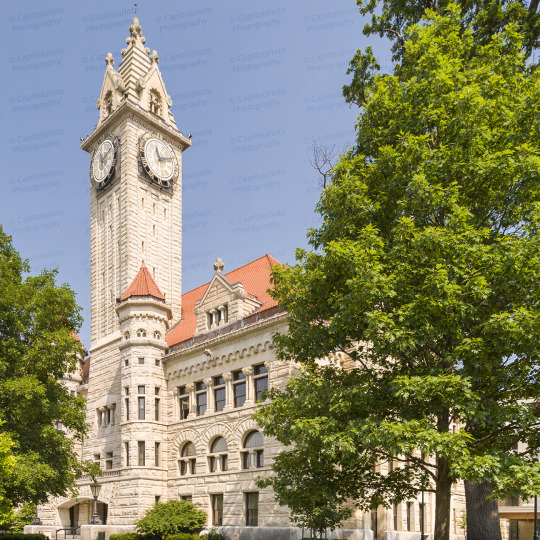

Wood County Courthouse
1 Court House Square
Bowling Green, OH 43402
The Wood County Courthouse and Jail, located in Bowling Green, Ohio, is Wood County's third courthouse. It was built after citizens decided to move the county seat from Perrysburg to Bowling Green. Ground was broken on November 28, 1893, and the cornerstone was laid on July 4, 1894. Joseph W. Yost and Frank L. Packard from the architectural firm of Yost & Packard of Columbus designed the courthouse and construction was overseen by T.B. Townsend of Youngstown. The winning tender for the project was $153,803 and the final construction costs totaled $255,746. The County Commissioners took possession of the new building on August 31, 1896, and the new Common Pleas Courtroom was dedicated on September 7, 1896.
Sandstone from Amherst, Ohio, granite from Vermont, and marble from Italy were used in the construction of the courthouse. Architecturally, it is Richardsonian Romanesque in design with architectural sculpting throughout the building done by Whyte and Priest of Dayton, Ohio. To facilitate construction, a temporary railroad along Pike Street was established to the construction site. Ornate stained glass panels cover much of the ceiling on the third floor and are visible from ground level due to the large open staircase which ascends through the middle of the second floor. The staircase consists of polished marble steps with brass railings.
The clock tower rises to a height of 195 feet. At the time of its construction, the clock hands were the second largest in America spanning 16 feet in diameter. They were exceeded only by the hands on the clock of the Chronicle newspaper building in San Francisco which were 16.5 feet in diameter. The clock was made by the E. Howard & Co. at a cost of $3000. The clock tower bells weigh 2,000 lb (910 kg).
Murals decorate the east and west walls of the third floor. The murals were painted by I. M. Taylor, who was the mayor of Bowling Green from 1911 to 1920. The east wall depicts Fort Meigs, a vital outpost in the War of 1812, and the west wall depicts a train passing through oil derricks in southern Wood County, a major producer of oil in the late 19th century.
A major restoration of the interior of the courthouse was undertaken in 1980, and a restoration of the exterior of the building was completed in 2002. President William Howard Taft held a rally at the courthouse in 1912. Jimmy Hoffa visited the courthouse on September 25, 1937 to get a marriage license, and married his wife in Bowling Green the same day. President Ronald Reagan delivered a speech at the courthouse on October 19, 1988 to promote the candidacy of George H. W. Bush. The building, located at 1 Courthouse Square in the county seat of Bowling Green, is still in use and today houses the Wood County Court of Common Pleas and its probate and domestic relations divisions.
There are two common pleas courtrooms and accompanying judicial offices located on the third floor as well as a jury assembly room, holding cell and conference rooms. A probate courtroom and judicial offices are located on the second floor, as is the Clerk of Courts Office. The first floor houses court security, court administration and a domestic relations courtroom with magistrates' offices and conference rooms. A five-story office building adjoining the courthouse contains a third common pleas courtroom and judicial offices as well as other county offices including the auditor, treasurer, engineer, commissioners, prosecutor, adult probation, building inspection and board of elections. A glass-enclosed atrium joining the courthouse and office building was completed in 2004. At that time existing entrances and exits to both buildings were closed and the atrium became the only public entrance to either building. It is staffed by court security who monitor people entering the buildings.
The clock tower is still in use. The original chimes are in working order and ring the hour, every hour, by denoting one chime per hour. All four clockfaces are quite remarkable, with two layers of Roman numerals. The inner layer closest to the center is golden and can be viewed easily when in shade. The outer ring on numerals is painted black iron which is easily readable when in direct sunlight. The tower also contains a box designed for use by nesting falcons. Construction of the old Wood County Jail, located next to the courthouse, was begun on May 21, 1901, and completed in 1902 at a cost of $49,000. The Fremont firm of Fronizer and Andrews constructed the building, which continued in use as the county jail until 1990.
Wood County is named after Maj. Eleazer D. Wood, an American Army officer in the War of 1812. Wood built Fort Meigs, which was located near Perrysburg, in 1813. This was used by American soldiers during the war to repel British attacks in the spring and summer of 1813. The courthouse was placed on the National Register of Historic Places in 1974.
2 notes
·
View notes